Reptiles
The reptiles on Saint Martin could be grouped into several categories: common and frequently seen, common but rarely seen, recently introduced, and probably extinct. More scientifically, including species that are possibly extinct here, there are eleven species of lizard, two snakes and one tortoise. This guide covers the ten species that I have seen and photographed.
The turnip-tailed gecko (Thecadactylus rapicauda) is cited in some literature as present on Saint Martin, although I have not seen it. It can be distinguished from the house gecko by its bulbous tail. The two-striped mabuya (Mabuya bistriata) is a skink that is cited as probably exterminated on the island. It is somewhat similar in appearance to Amieva plei, although it is shinier, moves in a smoother fashion and does not get as large.
The Lesser Antillean iguana (Iguana delicatissima) has been cited as probably exterminated from the island, although small populations still exist on other nearby islands. It is smaller than the common iguana (Iguana iguana), and lacks the large subtympanic scale present in that species. I have heard that some individuals may have been reintroduced, although interbreeding with the more common Iguana iguana makes it relatively unlikely that pure stock would remain on the island for very long.
The leeward island racer (Alsophis rijersmai), the only native snake on the island, is at best very rare. In fact, as early as the 1950s it was though to be eradicated, but specimens were seen in the 1990s. Apparently it is relatively common on Anguilla and St. Barths where there are no mongoose populations.
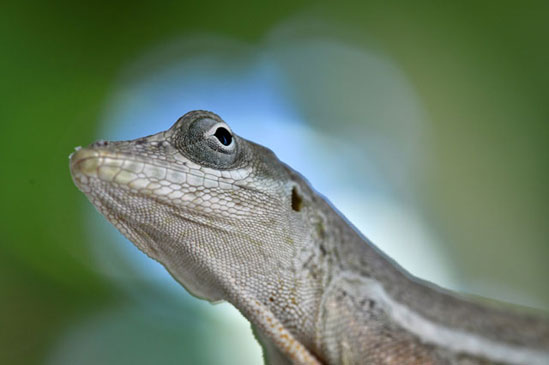
This Anguilla bank anole (Anolis gingivinus) was photographed in the branches of a sea grape tree on the beach in Grand Case, a typical habitat for this very common species. Anolis is the most diverse genus of lizards in the Caribbean and in the world.
Lizards
Anguilla Bank Anole (Anolis gingivinus)
Exceedingly common on St. Martin, Anguilla and St. Barths, this is one of many species historically considered part of the bimaculatus group of anoles found in the northern Lesser Antilles through Dominica and shares some characteristics with anoles of the Greater Antilles. Recent genetic analysis of these species indicates that the relationships between these species are more complicated than expected, and that A. gingivinus is a sister species to A. bimaculatus, which is found in St. Eustatius, St. Kitts and Nevis.
The Anguilla bank anole is the larger of the two anole species present on St. Martin and may be up to seven centimeters in snout-to-vent length (SVL), which basically means not counting the tail. It generally prefers sunny elevated perches, and is often seen on tree trunks or branches. It has white bands on either side of the belly and an irregular band across the top, although the dorsal band may be obscured by spots or mottling, particularly in males. The coloration varies from light tan to brown to green with an off-white belly. The dewlap is orange with white spots.
This anole is found essentially throughout the island. In relatively open areas it is much more common than the bearded anole (Anolis pogus), while in forested areas it is less common. It has been suggested that it is less common at higher altitudes, but I believe this is simply because that is where most of the dense forest still exists. Even atop Pic Paradis, the highest point on the island, Anolis gingivinus is very common in open areas.
When fighting over territory, males change color dramatically, developing a dark patch behind the eye and accentuating their spots. They can also raise a large crest down their back that is not normally there. Other color variations seem to be related primarily to camouflage.
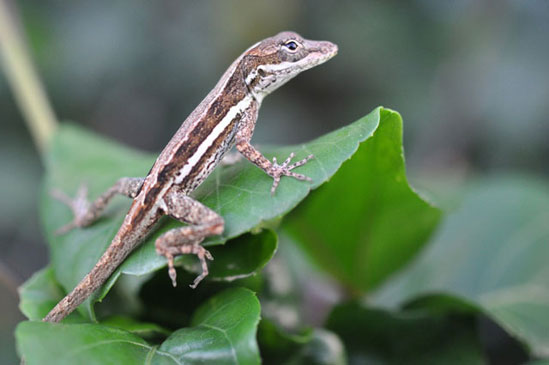
Anolis gingivinus displaying a fairly typical brown coloration with clearly visible dorsal band and white stripes on the sides. The dorsal band may be considerably less obvious in many individuals. Locally this species is often referred to as the tree lizard or fence lizard.
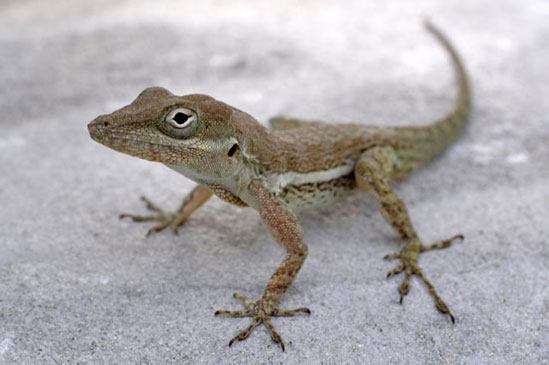
A tan coloration is not uncommon, and while the dorsal stripe may be subtle, the white stripes on the sides are almost always clearly visible.
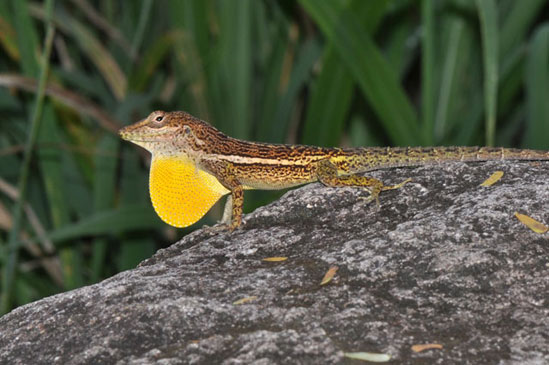
This male has fully extended his dewlap to impress a nearby female, or perhaps to intimidate me. I was undeterred.
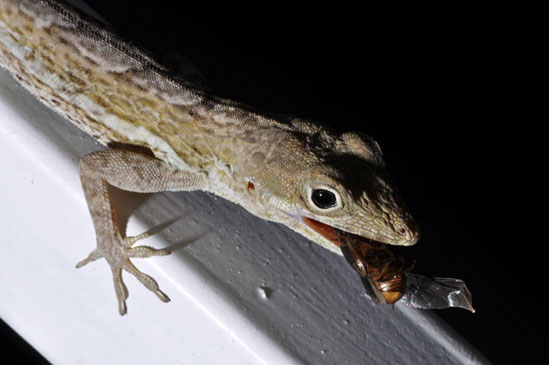
Although primarily diurnal, this species can be seen hunting at night, particularly near artificial lights where insects congregate.
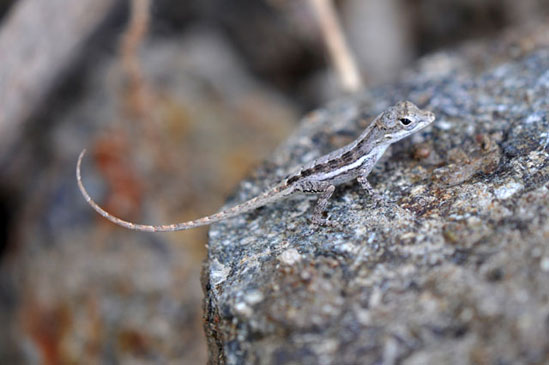
A juvenile has adopted a greyish color to camouflage itself in rocky terrain.
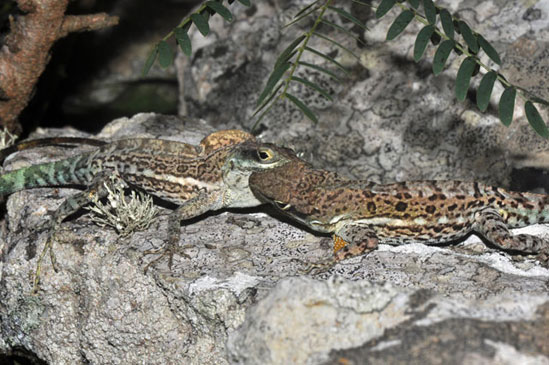
Males fight for choice territory on a stone wall. Note the extended dorsal ridges and exaggerated mottling that are common in aggressive displays.
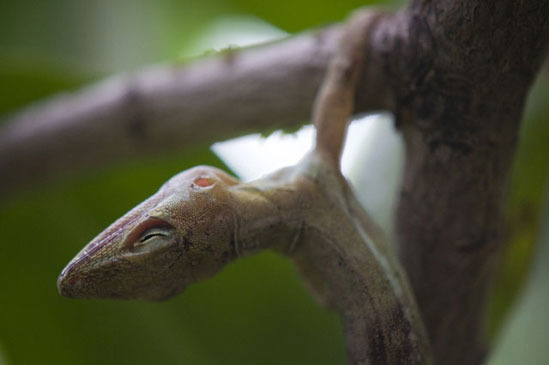
A testament to their ability to cling to branches, this individual was found dead, but still hanging from its final perch by a single forelimb.
Bearded Anole (Anolis pogus)
This anole is found only on St. Martin, although it once was also present on Anguilla and perhaps St. Barths. Until 1990, it was considered a subspecies of Anolis wattsi. Current species formerly grouped under A. wattsi include A. wattsi, which is native to Antigua and introduced to St. Lucia, Trinidad and Tobago, A. forresti, found on Barbuda and A. schwartzi, found on St. Eustatius, St. Kitts and Nevis. A. schwartzi and A. forresti are still considered subspecies of A. wattsi by some. The four species are very similar in appearance, and occupy analogous niches on their respective islands.
It is slightly smaller than the Anguilla bank anole, reaching a maximum SVL of about six centimeters. As it prefers shady areas, it most common on the forested hills and mountains, but can be found at sea level and even in developed areas if there is appropriate habitat. It is primarily seen on the ground or perched in the undergrowth or lower branches.
Coloration of this anole is highly variable. To some degree, the easiest way to identify it is by the lack of white bands on the sides. One common color pattern is tan with a turquoise patch around the eye. Darker brown and gray are also common, sometimes with light orange patches or bands. There may be a narrow, light dorsal stripe and irregular darker bands across the back, and these patterns vary from almost unnoticeable to very pronounced. The top of the head may be rust colored as well. In some cases the eye may be circled by red instead of turquoise, and when males are fighting for territory they may develop two black spots behind their eye. Like Anolis gingivinus, they are also capable of raising a crest down their back that is not normally present.
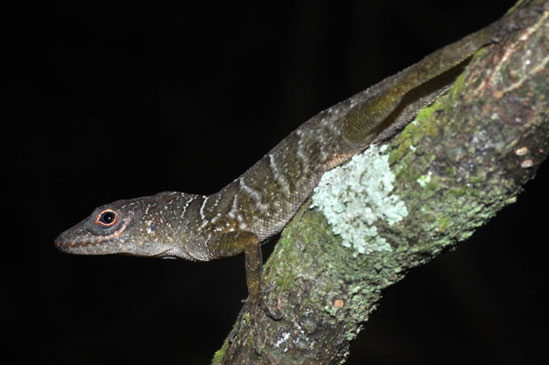
A bearded anole (Anolis pogus) displaying grey coloration, pronounced banding and red eye coloration. Although they are often found on the ground, they may also be found on tree trunks and branches in the forest.
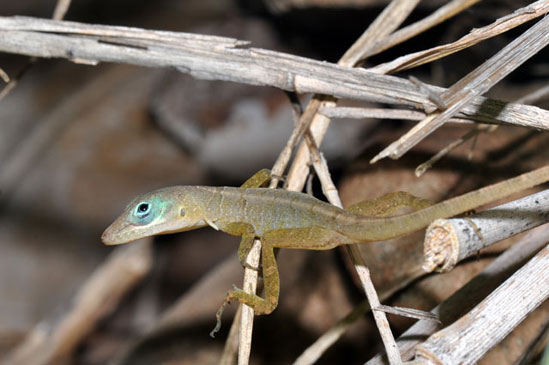
Anolis pogus exhibiting tan coloration and turquoise surrounding the eye. Dorsal stripe and banding across back are light, but clearly visible.
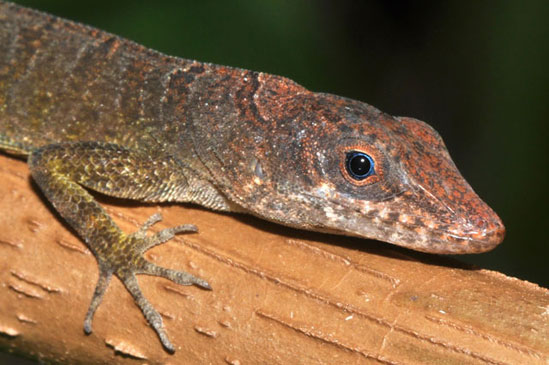
A specimen with a mottled red head and some banding, but no light-colored dorsal stripe. Changes in coloration are used for camouflage and communication, although the meanings are not well-understood.
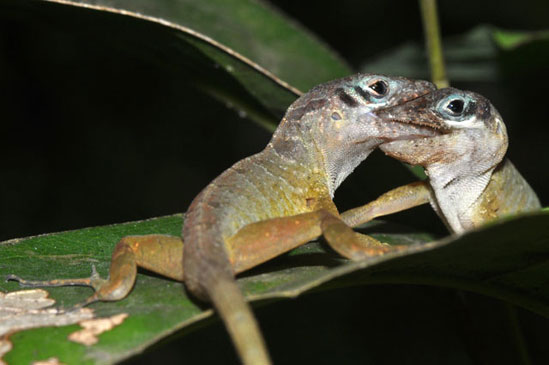
Males fighting over territory assume aggressive coloration, including double dark spots behind the eye. This battle lasted over ten minutes, starting at a perch six feet high and ending on the forest floor.
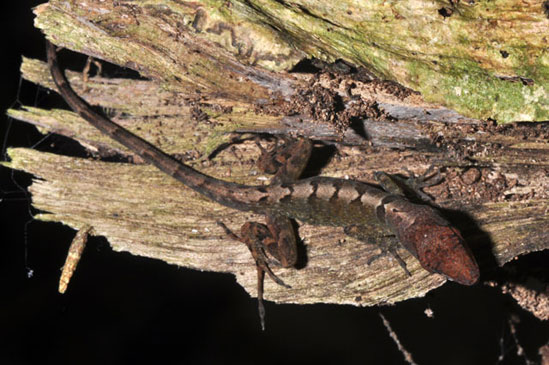
This coloration is more typical of dense forests where darker shades improve camouflage on bark and amongst leaf litter.
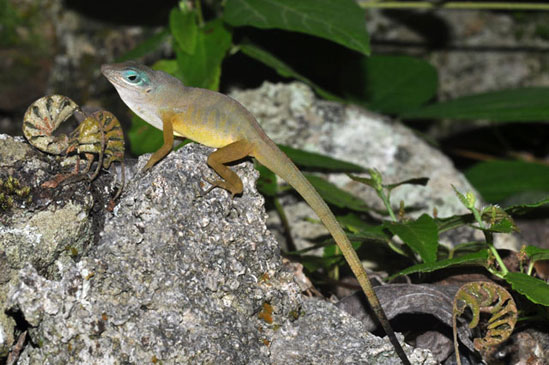
This male has extended a dorsal ridge and partially expanded its dewlap as part of a display. The tip of the tail is also almost black, which is a often part of this display.
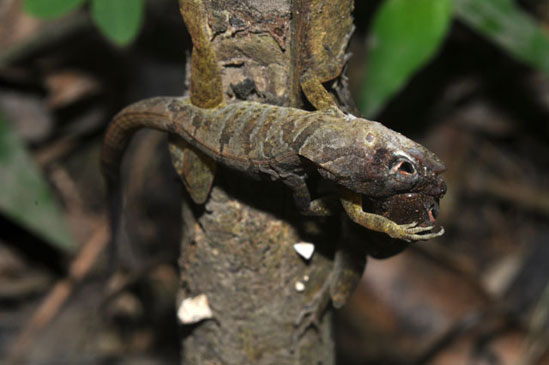
The same pair, still fighting a few minutes later, having changed to a strikingly different color and pattern.
Common Iguana (Iguana iguana)
The common, or green iguana is currently very common on St. Martin, but this was not always the case. Habitat destruction, mongoose predation and human consumption contributed to the extinction or near-extinction of this species on the island by the early 1990s. Since then, particularly in the last few years, they have either rebounded or re-colonized the island.
It is possible that escaped pets are the progenitors of the new population. Also, after hurricanes in 1995, a group of 15 iguanas adrift on a tangle of trees made an improbable overseas journey over 200 miles from Guadeloupe to Anguilla, where they were previously not found. At the time, this was the most extreme example of colonization by long distance rafting documented by scientists. It also seems possible that re-colonization of Saint Martin may have happened by natural means as well.
The green iguana is easily distinguished from its smaller cousin, Iguana delicatissima, by the presence of a large subtympanic scale. This is a round scale found below the lower jaw and is present on both juveniles and adults. While young specimens are bright green, this coloration gives way to primarily brown coloration as the iguanas mature. Some specimens may also be reddish-orange or nearly black. Banding down the back and black rings around the tail are also typical of the species.
This species is most common in wetland areas, often roosting in mangroves at the edge of salt ponds. When approached, they frequently run directly into the water. I have seen them descend and either not surface for several minutes, or swim underwater to surface unseen in a mangrove thicket. I have also seen them swim across salt ponds at the surface. In the late afternoon, they may often be seen sunning themselves on rocks or even seaside cliff faces.
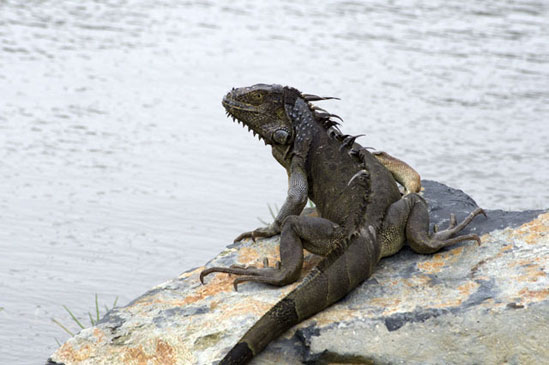
Very dark coloration is relatively common in adult iguanas, which often appear near black. After this photo was taken, this individual dove into the water and I did not see it surface.
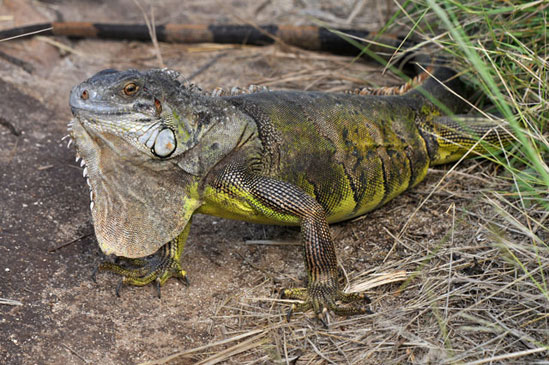
This individual was recently attacked by a dog while scavenging leftover vegetables behind a restaurant. Rather than running, it thrashed its tail as a defense mechanism when approached.
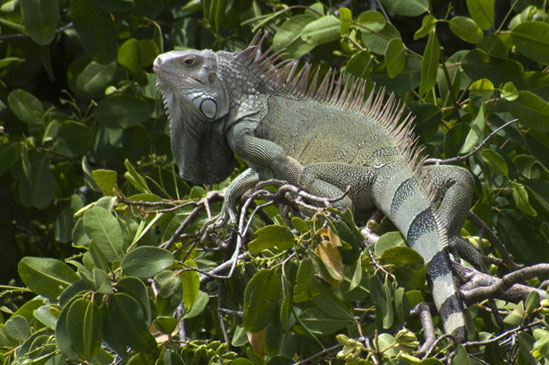
Lighter coloration in adults, including green, gray and orange hues is also common. Iguanas may often be seen perched on mangrove branches around salt ponds.
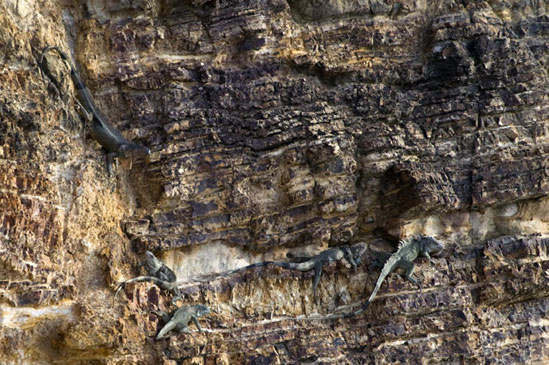
On the cliffs near Le Trou de David, groups of iguanas gather to bask in the late afternoon sunlight. They are quite adept at climbing, even on near-vertical cliff faces.
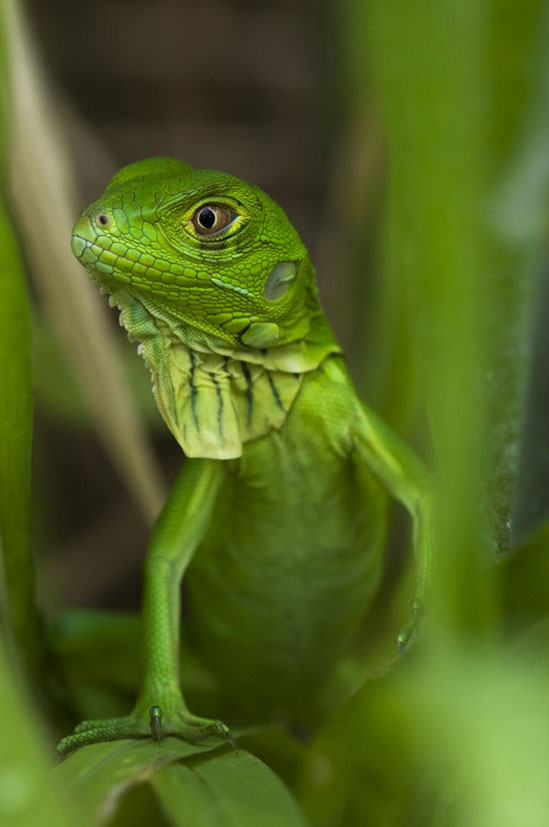
Juvenile iguanas are bright green, although this color fades as they age. Even at this early age, the subtympanic scale is visible, directly below the ear.
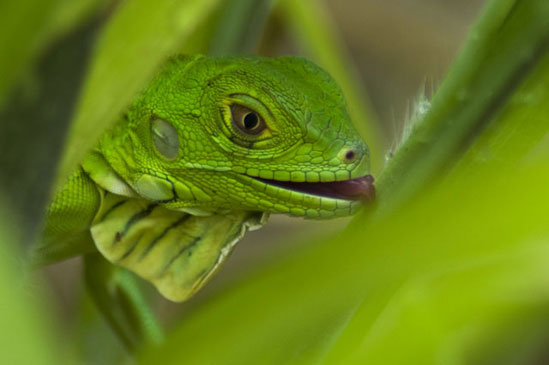
This very young juvenile iguana spent several minutes licking water droplets off leaves of grass after an afternoon rain shower.
Anguilla Bank Amieva (Amieva plei analifera)
Teiids from the genus Amieva are found on most of the islands in the Lesser Antilles. The species found on Saint Martin, Amieva plei, is also found on Anguilla and St. Barths, although the subspecies analifera is endemic to Saint Martin.
These ground-dwelling lizards are often quite large and, while fast, have an ungainly gait, skittering from side to side. Juveniles are typically brown with light stripes on the back running from behind the head to the hind legs. Both adults and juveniles typically have light spots from their hips down their tails. Some individuals have a greenish tint in the lower part of their body. Very large adults sometimes have black patches or bars on their shoulders, a characteristic that is only found in the Saint Martin subspecies.
These sun-loving lizards are often found on roadsides where they forage for insects and other invertebrates in the leaf litter. In some areas they may also be found at the edge of the beach. While they are often present in partially-forested areas, it is unusual to see them in dense forest.
While these lizards seem very common, because they are highly visible near human habitation, it is believed that their numbers are significantly suppressed by mongoose predation. On mongoose-free islands, Amieva are widespread, while on islands with mongoose populations, they tend to be restricted to developed areas that are avoided by mongoose. To some degree, it is possible that the continued development of Saint Martin offer some benefits to this lizard, but mongoose eradication would clearly be the preferred method for ensuring its survival.
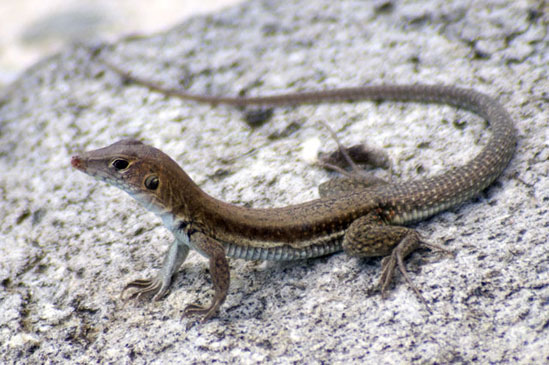
A typical specimen of Amieva plei analifera rests on a rock a few feet from the beach. Most commonly seen in sunny roadside areas, individuals can also be seen hunting for insects on the beach.
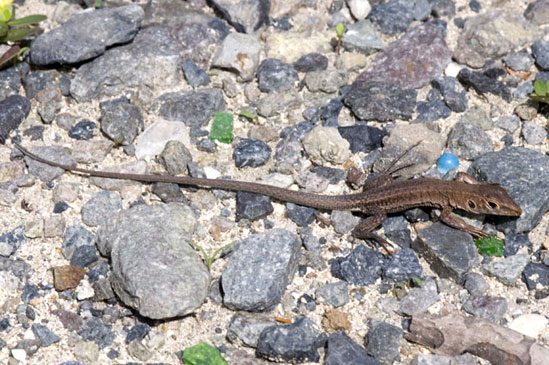
This juvenile is typical of the St. Martin subspecies, where even young juveniles have faded or otherwise indistinct stripes down their back.
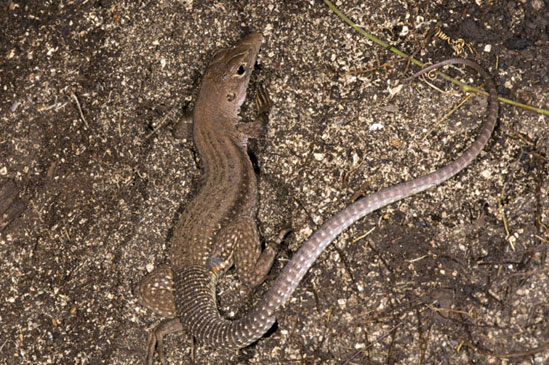
At night, the amieva hides in burrows under rocks and logs. As juveniles age, stripes on their back (if present) gradually fade until they disappear entirely.
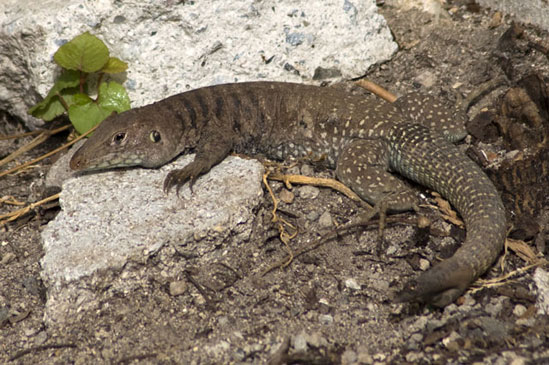
The description of subspecies analifera typically references three to five black bars on the shoulders of large adults, which are only present in this subspecies. In the largest individuals more bars may be seen.
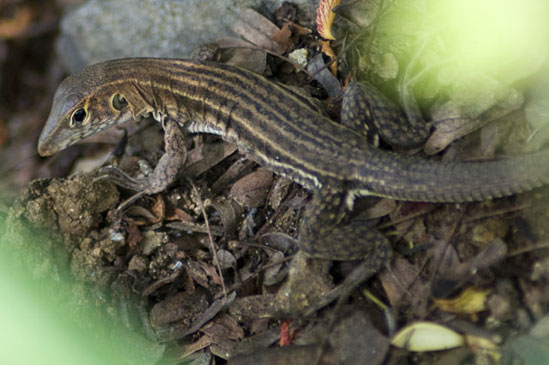
Some juveniles on St. Martin do have seven distinct stripes as this species does on other islands. It is unclear if this represents distinct populations, or a variable trait in the subspecies.
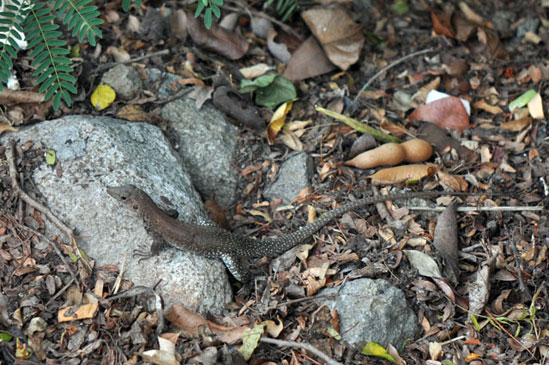
Mid-sized adults typically have neither stripes nor black bars, but do have white or green speckling from the posterior down the tail.
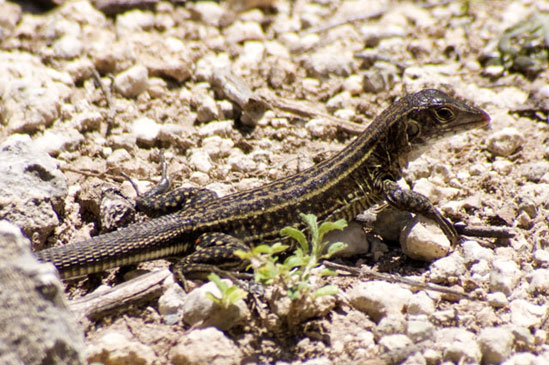
My research indicated that the satellite island Tintamarre is home to A. plei plei, the subspecies found on nearby islands, but not St. Martin. Specimens like this one do seem to have higher-contrast markings, but any differences seem subtle.
Dwarf Gecko (Sphaerodactylus parvus)
This diminutive gecko was considered a subspecies of Sphaerodactylus macrolepis until 2001, when it was elevated to species status. It is found only on the islands of the Anguilla Bank: Anguilla, St. Martin and St. Barths. To my knowledge, there is no common name for this species.
Parvus is slightly smaller than Sphaerodactylus sputator, reaching a maximum SVL of about 3.5 cm. They are typically a medium brown with scattered dark spots on the back. Just behind the head, there is a distinctive dark oval with two light spots and usually a light ring around it. The head often has a pattern of dark bands. For a gecko, the head is quite narrow and the eyes are quite small.
This gecko is typically found in leaf litter in forested parts of the island. A very observant hiker may notice these occasionally, but they are easiest to find by lifting stones or pieces of log from the forest floor to uncover them (and replacing them gently afterwards). I have found that geckos seem to be more common beneath wood and lighter stones where there is decomposing leaf litter and abundant invertebrate life. Heavier stones sunk into the soil do not seem to be popular.
They can also be found around human habitation, typically beneath boards or stones in shady areas. Very small eggs, a half-centimeter or less in length, may also be found beneath stones in areas where these geckos live, although I don’t know of any way to distinguish between the eggs of sputator and parvus without waiting for them to hatch.
Parvus coexists with sputator, and I have not discerned any difference in habits or preferred habitat. On the satellite islet Pinel, they are both quite common in the very limited amount of suitable habitat that exists.
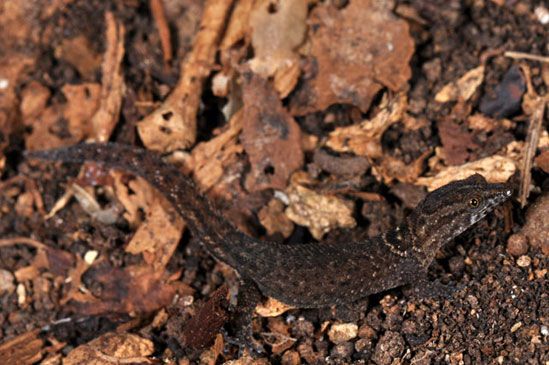
Sphaerodactylus parvus has a relatively narrow head and small eyes compared to other geckos, including the other local species of dwarf gecko, Sphaerodactylus sputator.
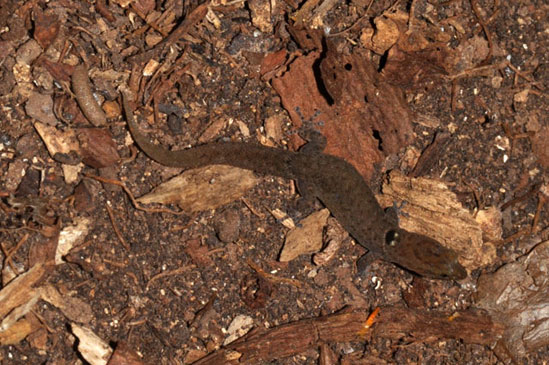
Variation coloration and patterning in parvus is subtle. This individual is relatively light in color, but retains all the typical patterning of the species.
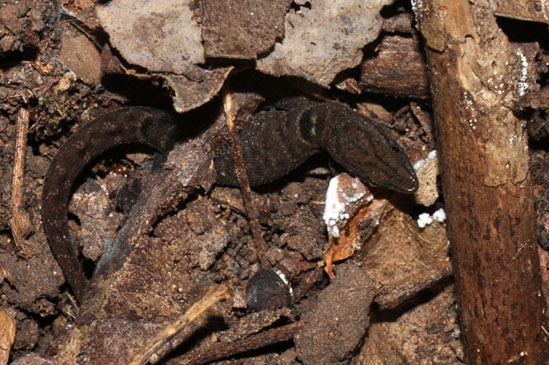
Leaf litter and other decaying organic matter is the preferred habitat for this species. Combined with its small size, this species can easily be overlooked, even where it is quite common.
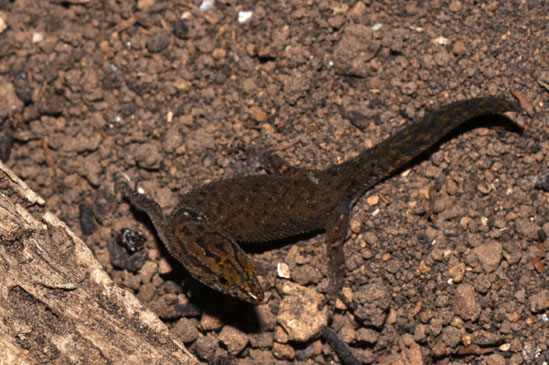
This individual is my closest example of the purported yellowish facial coloration. It is possible that the St. Martin population is somewhat distinct from those on Anguilla and St. Barths.
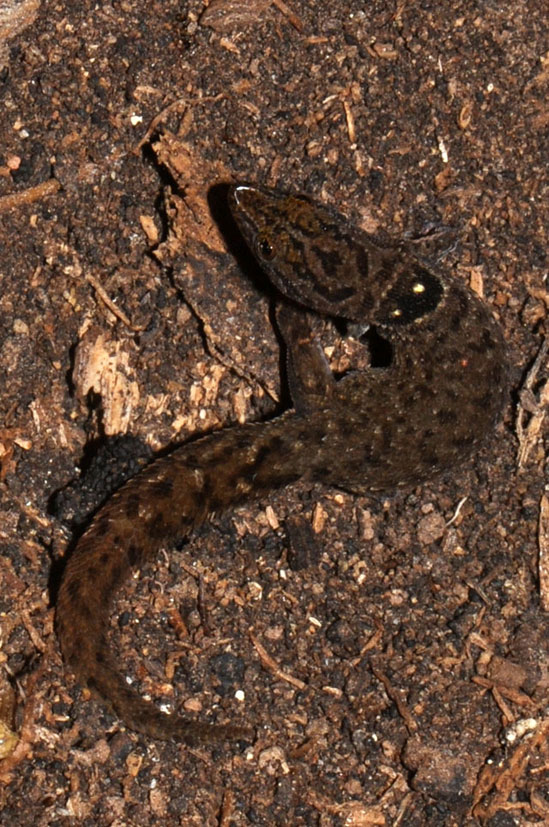
While some descriptions of the species cite a yellowish head, this does not seem to be present in the St. Martin population.
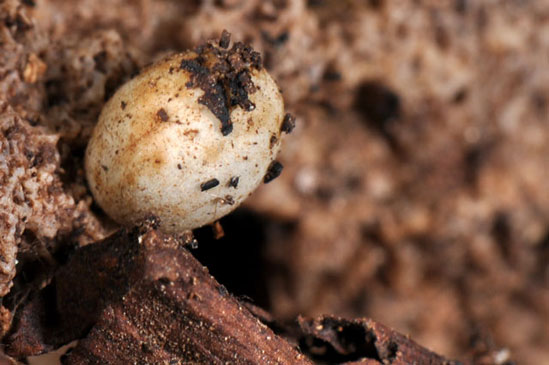
Eggs are typically laid in protected concavities on the underside of rocks or logs. This particular egg may be that of parvus or sputator.
Least Island Gecko (Sphaerodactylus sputator)
Sphaerodactylus sputator can be found on a half dozen islands, including Sombrero, Anguilla, St. Martin, St. Barths, St. Eustatius, St. Kitts and Nevis.
Typical coloration is grey with broken white stripes and dark bands on the back. An orangish tail and bronze iris are cited as characteristics that are specific to the population on St. Martin. Close inspection may reveal occasional raised red scales scattered around the body. This species has a very typical gecko shape, with very large eyes and a broad head.
Darker individuals may be confused with S. parvus, but the size of the eyes and shape of the head can aid with identification. Females may reach nearly four cm in SVL, slightly larger than S. parvus, but the difference is not noticeable unless one was to measure them, which would be challenging.
In my observation, the habits and preferred habitats of the two species of dwarf gecko are indistinguishable. S. sputator more closely resembles other dwarf geckos in the Lesser Antilles, while S. parvus is closely related to S. macrolepis which is present in Puerto Rico and Central America. This may indicate that the two species arrived at different times or from different directions. Despite being the same size and sharing the same habitat, populations of the two species seem to be entirely distinct, suggesting that interbreeding is impossible.
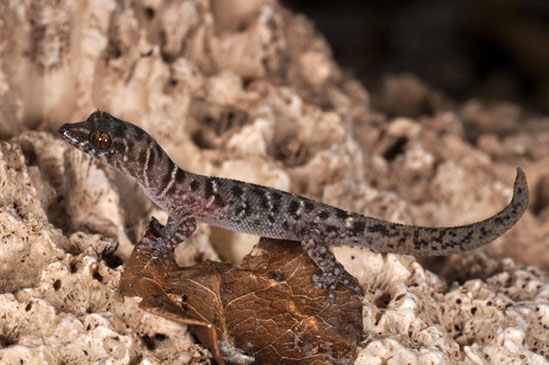
This specimen was found on the underside of a chunk of coral skeleton in a small, forested area of Pinel, a habitat that it shares with S. parvus. The orange hue of the tail, which is described only for the St. Martin population is not visible on this individual.
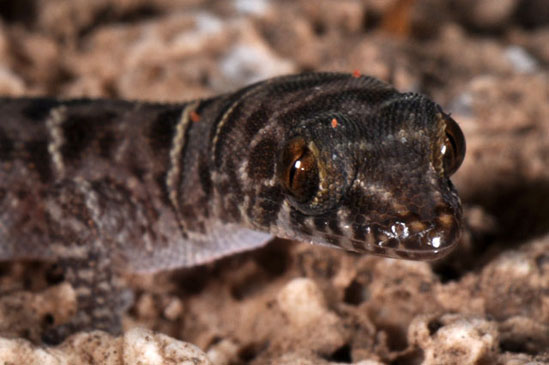
In this close-up, several raised, orange-red scales can be seen on the head and neck.
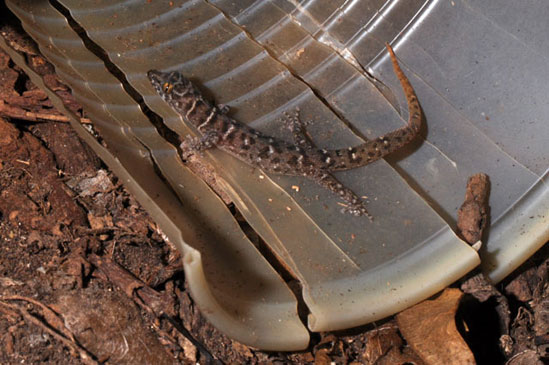
This individual is seen in the remains of a plastic cup, illustrating the typical size of an adult. The orange tail and bronze eye typical to the St. Martin population are visible in this individual.
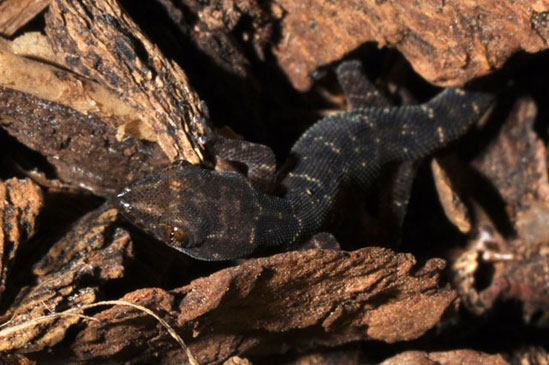
This particularly dark individual was found only a few meters from some of the much lighter specimens pictured on this page.
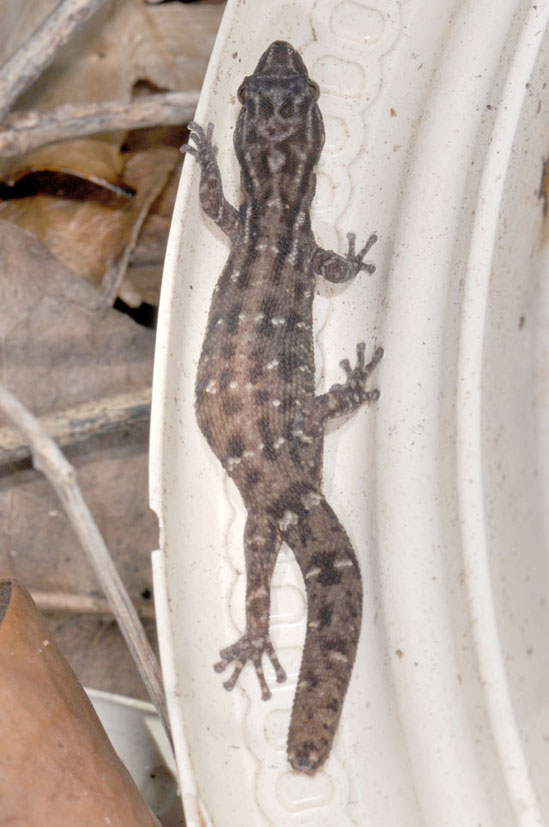
This female has an egg clearly visible on her left side. This species lays one egg at a time, and that egg is extremely large compared to the adult body size.
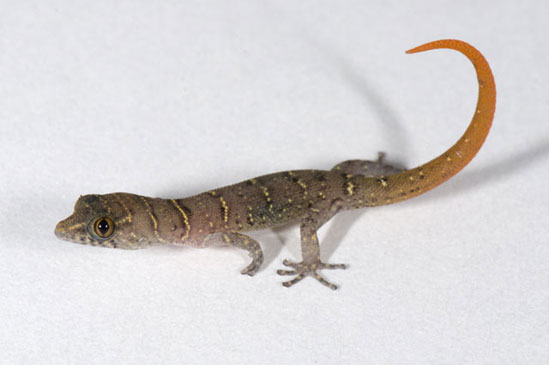
Until I encountered this juvenile, I had assumed that the description of an orange tail meant an orangish cast. To date, this is the only one I have encountered with a truly orange tail. The white patterns are also distinctively yellow on this individual.
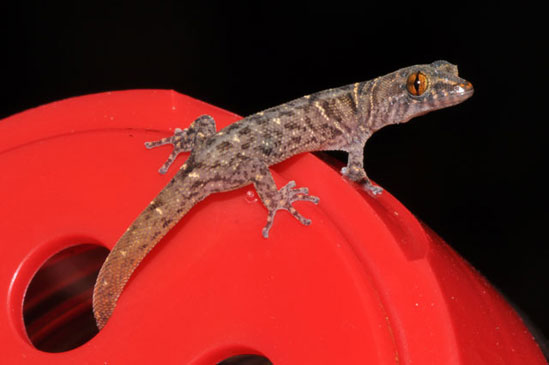
This juvenile is resting on the lid of a small spice jar. The hole where its tail is resting is approximately 6mm in diameter.
Tropical House Gecko (Hemidactylus mabouya)
This medium-sized gecko (up to 7 cm in SVL) is native to sub-Saharan Africa, but now lives in tropical areas of North, Central and South America as well as most islands in the Caribbean. It was likely introduced to the Americas inadvertently.
Coloration can vary dramatically, from very pale or pinkish with few visible markings to a mottled grey or brown coloration. It is often seen at night in or around homes and other buildings, but can also be found under boards or rocks in some grassy areas. Eggs are typically laid in pairs in rotting wood or beneath stones.
Like other geckos, minute setae (hair-like bristles) on their toe pads give them the ability to easily climb vertical surfaces. This gecko also has the ability to spontaneously drop its tail when frightened to distract predators.
While these insectivores are welcome guests in many homes, it is unknown what negative impact they may have on native species.
Locally geckos are often called woodslaves. Their climbing abilities have inspired a local legend that if you get one on your skin you need to use a hot iron to remove it because it will stick too strongly to remove it otherwise.
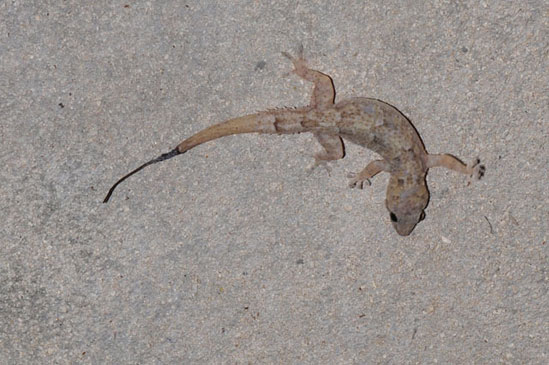
An individual with a necrotic tail. Presumably it had attempted to drop its tail but it had not completely detached.
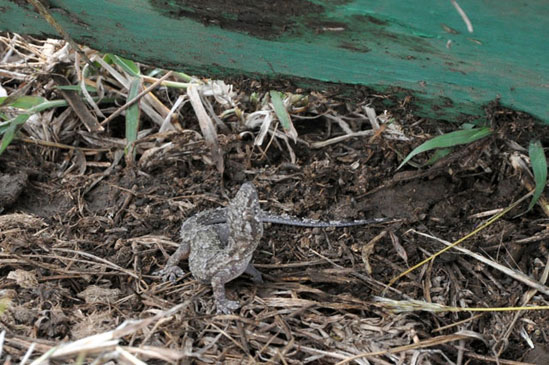
This individual is surprised to find his home (a discarded wooden gate) suddenly lifted. This mottled gray coloration is typical of individuals living in grassland areas.
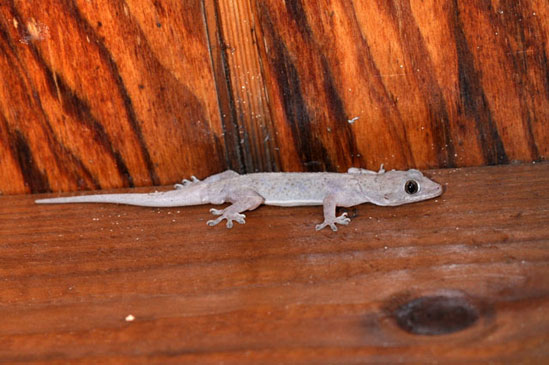
This very pale individual is seen perched near the roof of a home. Despite their speed and agility, they are very wary of humans and quickly flee when approached.
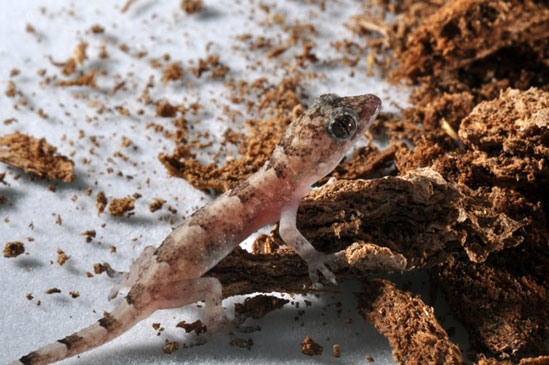
This newly-hatched juvenile is approximately two centimeters long. Shortly before hatching, one can feel the movement of the baby inside the egg.
Underwood’s Spectacled Tegu (Gymnophthalmus underwoodi)
This lizard is a microteiid, and is similar in size to the dwarf geckos. Its previously described range includes parts of Central and South America as well as a number of islands in the Lesser Antilles, although none particularly near St. Martin. I would guess that it is a relatively recent introduction to St. Martin, done inadvertently by man.
These lizards have a shiny tan back with darker sides and an elongated body shape with a very long tail. It could be possible to confuse them with a young skink (if there are any on the island) or ground lizard, but I think it is unlikely. If in doubt, identification may be confirmed by the presence of only four toes on the front feet.
Typical habitats for these lizards are sunny grassland areas or scrublands. They may be seen beneath rotting logs in open areas, but they also forage openly in the grass. Due to their small size they may easily be overlooked.
This curious lizard is unisexual and reproduces parthenogenically. This may be a key factor in its ability to colonize new islands, as a single individual can reproduce to start a new population.
This lizard is named after Garth Underwood, a pioneering British herpetologist responsible for much important work on reptiles in the Caribbean, including significant revisions to the taxonomy of Anolis species of the Lesser Antilles in the late 1950s.
A related species, Gymnophthalmus pleei, is found on some of the Lesser Antilles and is quite similar in appearance, but is not known to reside on St. Martin. It has ridged scales on the tail, which offer a subtle point of differentiation. As its range includes other French West Indies (Martinique and Guadeloupe), it would not be too surprising for G. pleei to arrive in the future as an accidental introduction.
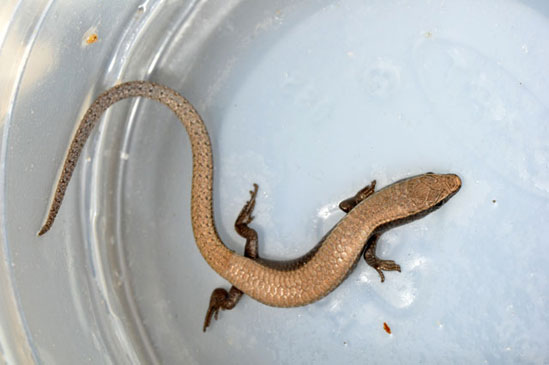
This individual was found in a grassy roadside area near Étang Guichard. The lack of ridged scales on the tail helps distinguish it from G. pleei.
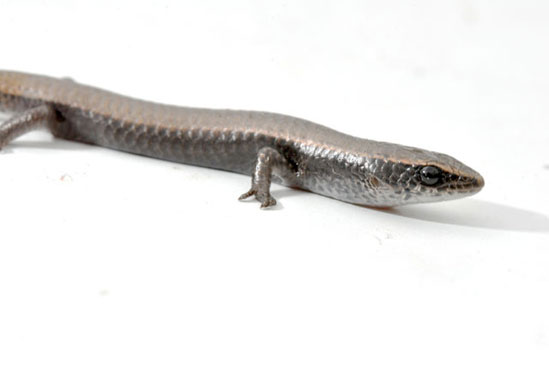
Microteiids have transparent lower eyelids, allowing them to see with their eyes closed. This characteristic is what led them to be called spectacled lizards.
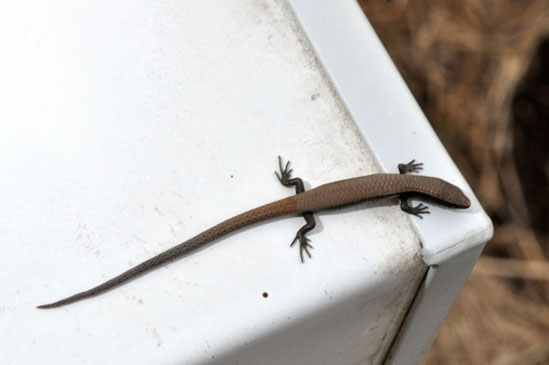
In this photo, the presence of only four toes on the front feet is clearly noticeable, as is the extremely long tail.
Snakes
Brahminy Blind Snake (Ramphotyphlops braminus)
This strange-looking snake is native to Africa and Asia, but has been introduced to many areas around the world. Sometimes called the flowerpot snake, it is thought that this species has been introduced in part through stowaways traveling in potted tropical plants. It is probably introduced to Saint Martin only recently.
This snake is very small, reaching only about 17 cm in length, and has a worm-like appearance. It is, however, a surprisingly fast mover. Its eyes are rudimentary and are covered with scales, limiting its vision. They seem to sense light and darkness, but probably nothing more than that. The tail is quite short and may be hard to distinguish from the head.
This species is likely to have a limited range, and I have only seen them in Grand Case. They are typically found under stones, bricks or boards, but apparently may be seen in the open after heavy rain. When captured, they thrash violently and excrete a smelly substance from a pair of glands near the base of the tail to discourage predators.
Like Gymnophthalmus underwoodi, this species is parthenogenic, and all specimens collected have been female. Several other species of blind snake are present in the Caribbean, but none are recorded on Saint Martin.
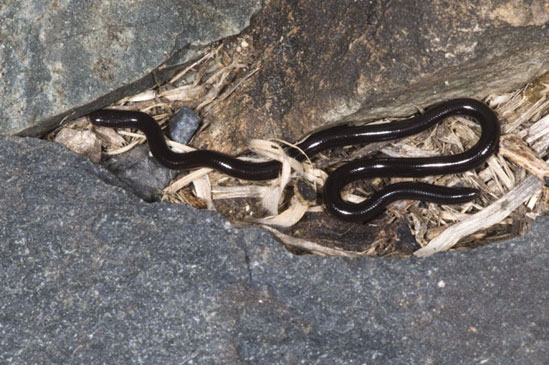
Although it is usually hiding during the day, the blind snake may occasionally be seen hunting at night. This one was crawling across a stone wall in search of invertebrate prey.
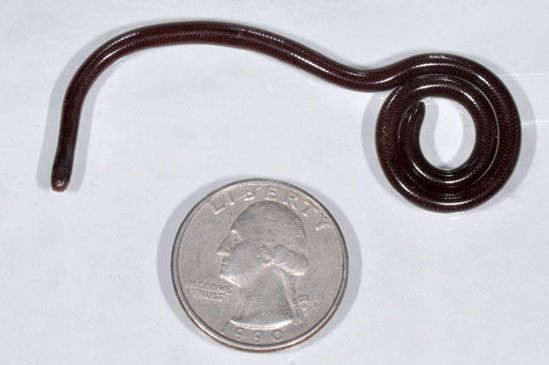
An adult specimen seen with a quarter for scale. Juvenile specimens I have seen are several times smaller.
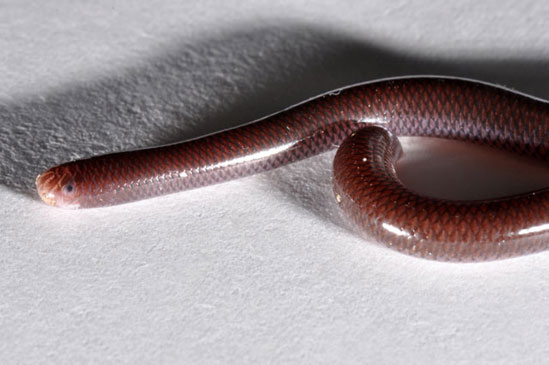
In this closer view of the head the rudimentary eye can be seen as a dark spot beneath translucent scales.
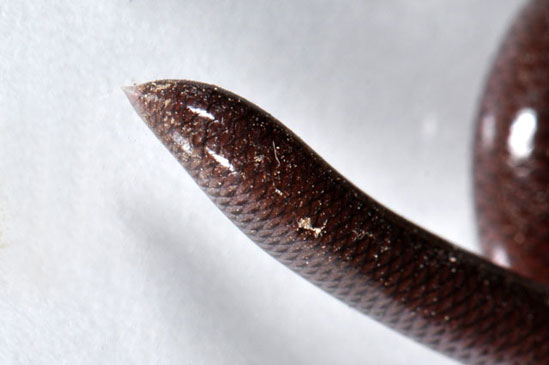
The tail is very short and comes to a sharp point at the end. When fleeing predators, this snake tends to move both ends similarly, perhaps to cause confusion about which end is which.
Tortoises
Red-footed Tortoise (Geochelone carbonaria)
This is the only species of tortoise found in the Lesser Antilles. Native to South America, it may have been introduced by Arawak or Caribe settlers as a food source before European colonization, or perhaps later either for food or as escaped pets. This genus also includes the giant tortoises of the Galapagos islands.
This medium-sized tortoise is typically 25 to 35 cm in carapace-length and can easily be identified by the yellow and orange spots in the center of the plates on the back of its shell, as well as the yellow to red scales on its face and limbs. The shell is somewhat rectangular, but mature specimens tend to develop a noticeable “waist” mid-shell which gives them an hourglass appearance.
Their round, brittle eggs, which are laid in small clutches, may be eaten by mongoose and rats. Their natural habitat is ranges from forest to grassland areas, and their diet is omnivorous, including carrion as well as fruits and plants.
This species does not seem to be particularly common. I have seen one individual crossing a path in a scrubby area of Pinel and know that they are present on Goat Mountain. In the past, they were common on Tintamarre as well, but are now thought to be rare there, the majority being taken home for pets, or dinner. There are apparently a great many of these turtles in captivity on the island, and they breed readily in this situation.
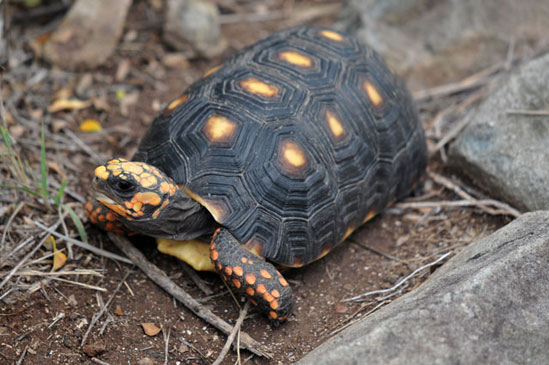
This individual was probably a young adult, approximately 25 cm in carapace length. Its ability to last long periods without food or water is probably an advantage during the dry season on St. Martin.
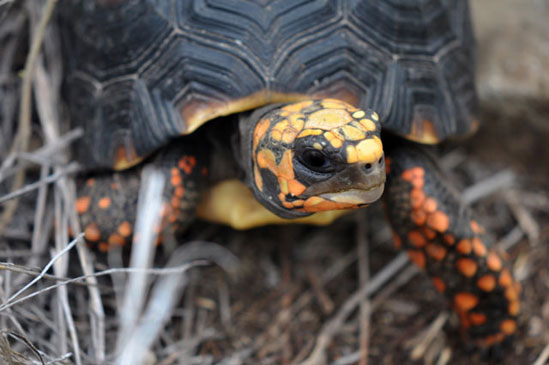
This specimen was seen in the late morning. Typically, they are active in the morning and evening, seeking shelter during the mid-day heat.
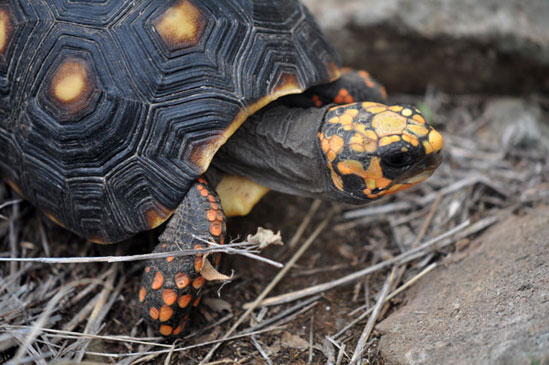
There are many varieties of this tortoise throughout its range, although none have been formally classified as distinct subspecies as yet.
Sea Turtles
In addition to the terrestrial reptile species covered in this volume, four species of sea turtle are known to live in the seas surrounding the island: the green turtle (Chelonia midas), hawksbill (Erytmochelys imbricata), loggerhead (Caretta caretta) and leatherback (Dermochelys coriacea). Only the hawksbill and green turtles are regularly seen when diving or snorkeling, as the loggerhead and leatherback primarily live in the open ocean rather than reefs or sea grass beds. Hawksbill, green and leatherback turtles all nest on the island and nearby islets. Although less common than in the past, tracks and nests can be seen from April through November, particularly on more secluded beaches.
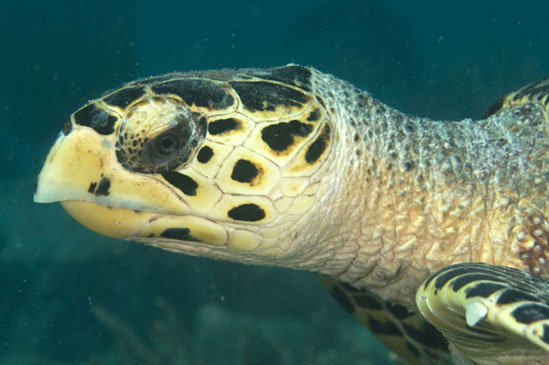
Hawksbill turtles are frequently seen by divers and snorkelers on the reefs where they feed. Green turtles are also a relatively common sight, particularly in sea grass beds.
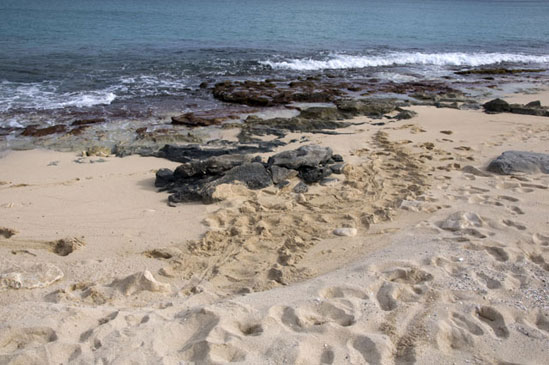
Tracks from a leatherback turtle show her ascent up the beach to find a suitable nesting site. Many attempted nests are aborted, often due to the presence of dogs.
